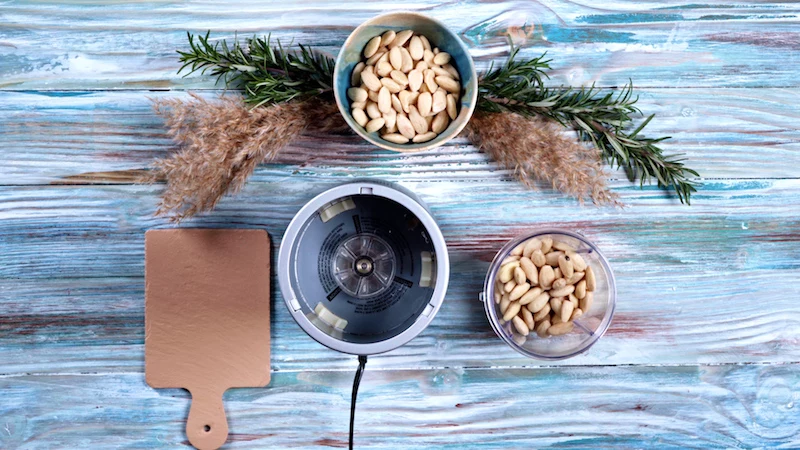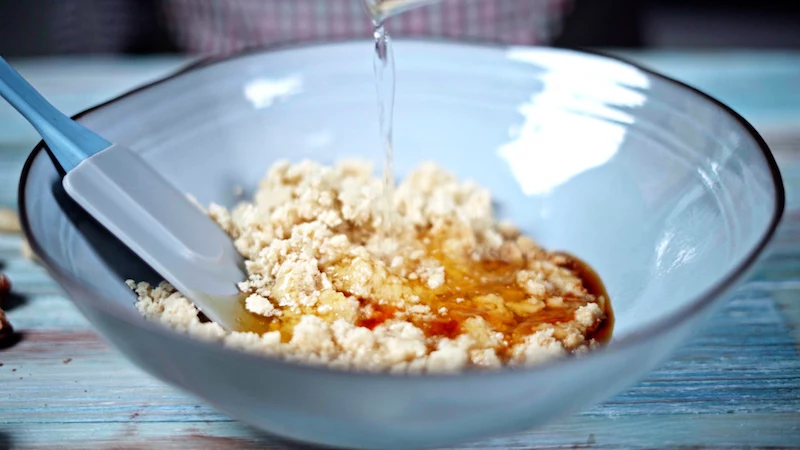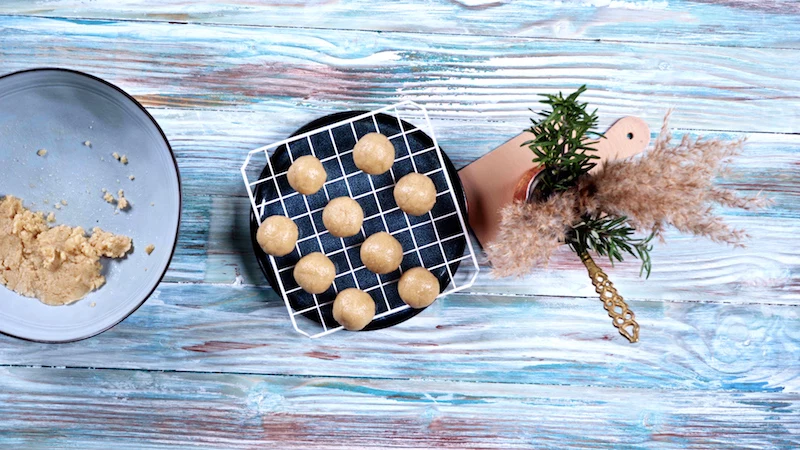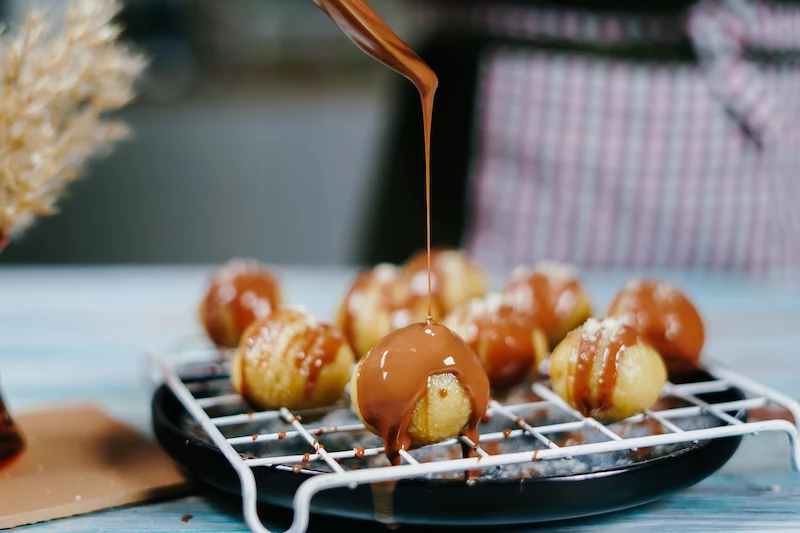Why Homemade Marzipan Is a Game-Changer (And How to Actually Make It)
I’ve been working with chocolate and sugar for a good long while, and one of the first things I always teach new apprentices is the art of marzipan. It sounds so basic, right? Just almonds, sugar, and a little something to hold it all together. And yet, my first professional attempt was a total train wreck—an oily, separated mess that taught me a lesson I’ve never forgotten. Making truly great marzipan isn’t about just following a recipe; it’s about understanding your ingredients. It’s a craft.
In this article
- What’s Actually Happening in the Bowl?
- Choosing Your Ingredients: The Pro’s Take
- The How-To: A Step-by-Step Guide
- Step 1: Get Your Almonds Ready
- Step 2: Cook the Sugar
- Step 3: Bring It All Together
- Step 4: The All-Important Rest
- Troubleshooting Common Problems
- Putting Your Masterpiece to Work
- A Quick Word on Safety and Storage
First things first, let’s clear up a common mix-up. People often use “marzipan” and “almond paste” like they’re the same thing. They’re not. In a professional kitchen, this difference is a big deal. The secret is the ratio of almonds to sugar. Marzipan has more sugar, making it sweet, smooth, and flexible—perfect for molding into little fruits or covering a cake. Almond paste, on the other hand, is loaded with more almonds and less sugar, giving it a slightly coarser texture and a powerful almond punch. It’s the stuff you want as a filling in pastries, like a bear claw or a frangipane tart.

For the really good stuff, the pros often look to traditional quality standards. The best marzipan, sometimes called Edelmarzipan, might have a 70:30 or even a 90:10 ratio of almond paste to extra sugar. The more almonds, the richer (and pricier) it gets. So, is it cheaper to make it yourself? Honestly, if you go for the fancy almonds, not always. But the difference in flavor and texture compared to the stuff in a tube from the grocery store? It’s night and day.
What’s Actually Happening in the Bowl?
Before you even open a bag of almonds, it helps to know what’s going on behind the scenes. Making marzipan is basically a game of managing an emulsion. You’re grinding nuts to release their natural oils and then mixing that oily, solid goodness with sugar syrup. The mission is to create a perfectly smooth, stable paste where the oil doesn’t separate. This is why temperature is everything.

If you grind the nuts too aggressively, they heat up, and the oil breaks free from the almond solids. Hello, greasy disaster. On the flip side, the sugar is doing its own magic. When you cook sugar and water into a syrup, the crystals dissolve. As it cools, the sugar wants to crystallize again, but the finely ground almonds get in the way, keeping the texture smooth instead of grainy. By the way, adding a little invert sugar, like corn syrup or glucose, is a pro move that helps block crystallization even more, guaranteeing a silky-smooth finish.
Choosing Your Ingredients: The Pro’s Take
With a recipe this simple, there’s nowhere for mediocre ingredients to hide. Every single component shines through, so picking the good stuff is step one.
The Almonds: Heart of the Matter
The type of almond you use makes all the difference. California Nonpareil almonds are easy to find and have a great, classic flavor. They’re a solid, reliable choice. But if you want to make something truly special, hunt down some Spanish Marcona almonds. They’re a bit sweeter, a lot softer, and have a higher oil content that creates an incredibly tender paste. They are pricier, though—expect to pay around $15 to $25 per pound online, while the California ones are usually closer to $10 to $15 per pound.

You’ll need blanched, skinless almonds. You can buy them that way or do it yourself. Just drop raw almonds in boiling water for exactly 60 seconds, drain, and shock them in an ice bath. The skins will slide right off. Here’s a critical tip: let them dry completely, spread out on a tray for at least 24 hours. Any leftover water will mess with the texture of your final product.
And please, smell your almonds! Almond oil can go rancid. They should smell sweet and nutty. If you get even a whiff of something stale or paint-like, toss them. That bad flavor will ruin your marzipan.
The Sweetener: It’s All About the Texture
Your choice of sweetener really dictates the final feel and sweetness. Here’s the breakdown:
- Classic Sugar Syrup: This is the traditional method we’ll use below. You cook granulated sugar and water to the “soft-ball stage.” It requires a bit of attention but produces a firm, stable marzipan that’s amazing for shaping and modeling.
- Powdered Sugar: Some quick recipes call for this. It lets you skip cooking syrup, but the cornstarch in most powdered sugars can sometimes leave a slightly chalky taste and a grainier texture. It works in a pinch, though!
- Honey: This adds a beautiful flavor and keeps things moist. The downside? It can easily overpower the almonds. If you go this route, pick a very light, mild honey (like clover) and expect a softer, stickier result.
- Corn Syrup or Glucose Syrup: This is the secret weapon for an ultra-smooth texture. As an invert sugar, it’s brilliant at preventing crystallization. Just a tablespoon of light corn syrup can make a huge difference in keeping your marzipan smooth for longer.

The Binder and Flavor
A little liquid brings the dough together. Traditionally, rosewater was the go-to, and it adds a beautiful, subtle floral note. Many modern recipes use almond extract instead. A word of caution: cheap almond extract can taste harsh and synthetic. If you use it, add it literally one drop at a time. For the best flavor, I like to use a tiny bit of both—a few drops of a high-quality almond extract and a splash of rosewater creates a really lovely, complex flavor. Look for an extract brand that uses real bitter almond oil, like Nielsen-Massey; it’s a world away from the imitation stuff.
The How-To: A Step-by-Step Guide
This method, using a cooked sugar syrup, takes more effort, but the payoff is a far superior marzipan. Read through the steps first, and get all your gear ready to go.
Yield: About 1 pound (450g) of marzipan
Time: 45 minutes active, plus 24 hours to rest

Equipment You’ll Need:
- Digital kitchen scale (seriously, it’s essential for baking)
- Food processor (or a powerful blender, see note below)
- Small, heavy-bottomed saucepan
- Candy thermometer (or a bowl of ice water)
- Silicone spatula
- Clean work surface (marble is great if you have it)
- Plastic wrap
Ingredients:
- 250g blanched, skinless almonds (must be very dry)
- 125g granulated sugar
- 125g powdered sugar, plus extra for dusting
- 60ml water
- 1 tablespoon light corn syrup (optional, but highly recommended)
- 1/2 teaspoon high-quality almond extract
- 1/4 teaspoon rosewater
Step 1: Get Your Almonds Ready
The goal is a fine powder without making hot almond butter. I’ve seen apprentices burn out motors by just letting the food processor rip. Don’t be that person.
- Combine and Pulse: Put the 250g of almonds and 125g of powdered sugar in the food processor. The sugar helps absorb oil and keeps it from getting greasy too fast.
- Pulse, Rest, Repeat: Pulse in short 5-10 second bursts. After every few pulses, stop, scrape the sides, and feel the mix. If it’s getting warm, walk away for a few minutes. Patience is your best friend here.
- Check the Texture: Keep going until you have a powder that feels like fine cornmeal. Don’t overdo it. Transfer this almond flour to a large, heatproof bowl.
Quick Tip: No food processor? A high-powered blender can work, but you have to be even more careful. Use the pulse function in very short bursts. Your other option is a mortar and pestle, but prepare for a serious arm workout!

Step 2: Cook the Sugar
This is where you need to focus. Hot sugar is no joke and can cause nasty burns, so be careful. Keep a bowl of ice water nearby just in case.
- Combine and Heat: In your saucepan, mix the 125g granulated sugar, 60ml water, and the optional corn syrup. Stir just until the sugar is wet, then put it over medium-high heat.
- Clip and Watch: Clip your candy thermometer to the side of the pan, making sure the tip is in the syrup but not touching the bottom.
- Hands Off! Once it boils, don’t stir. Stirring can cause crystals to form, making your marzipan grainy. If you see crystals on the side of the pan, just brush them down with a wet pastry brush.
- Hit the Magic Number: Cook the syrup until it reaches the soft-ball stage, which is between 235°F and 245°F (112°C – 118°C). This is a rule, not a suggestion. Too low and the marzipan will be wet; too high and it’ll be crumbly.
Heads up! No candy thermometer? No problem. Generations of cooks used the cold water test. As the syrup cooks, drizzle a tiny bit into a bowl of ice water. If you can scoop it up with your fingers and form a soft, squishy ball, you’re there. It takes a little practice, but it’s a fantastic skill to have!

Step 3: Bring It All Together
Once your syrup is ready, it’s go-time. Work quickly.
- Pour and Mix: Immediately pour the hot syrup in a steady stream over your almond flour mixture. Use a silicone spatula to mix like crazy. It’ll look lumpy and weird at first, but keep stirring until a shaggy dough forms.
- Add Flavor: Stir in your almond extract and rosewater.
- Knead Briefly: Dust a clean counter with powdered sugar and turn out the warm dough. Let it cool just enough so you can handle it. Knead for just 30 to 60 seconds—you’re just trying to make it smooth, not develop gluten like bread. Over-kneading will make it oily.
Step 4: The All-Important Rest
This is the step everyone wants to skip, but it makes a huge difference in flavor and texture.
- Wrap It Up: Form the dough into a flat disk and wrap it tightly in two layers of plastic wrap. Press the wrap right against the surface so a skin doesn’t form.
- Let It Be: Store it in a cool, dark place (like a pantry) for at least 24 hours. Don’t refrigerate it yet. This resting period lets the flavors meld and the texture stabilize. It’s so much better the next day.
Quick Win: Don’t have a big project in mind? The absolute easiest way to enjoy your hard work is to roll the finished marzipan into little balls and dust them with cocoa powder. It’s a two-minute treat that lets you taste your success immediately!
Troubleshooting Common Problems
Even with experience, things can go sideways. Here’s how to fix the most common issues.
The Number One Tip to Prevent Disaster: Before you even start, chill your food processor bowl and blade in the fridge for 20 minutes. A cold environment is your best defense against an oily, separated mess.
- Problem: It’s oily and separated.
The Cause: You probably over-processed the nuts or the kitchen was too warm.
The Fix: This is a tough one, but it’s sometimes salvageable. Chill the paste for 30 minutes, then turn it out onto a very cold surface and try kneading in a tablespoon of powdered sugar. Work fast in a cool room. - Problem: It’s dry and crumbly.
The Cause: The sugar syrup got too hot.
The Fix: This is an easier fix. Knead the dough on a surface lightly dampened with a few drops of water or rosewater. Add liquid a tiny bit at a time until it comes back together. - Problem: It’s too wet and sticky.
The Cause: The syrup didn’t get hot enough, or you went a little wild with the flavorings.
The Fix: Just knead in more powdered sugar, a tablespoon at a time, until the paste is smooth and no longer feels tacky.
Putting Your Masterpiece to Work
Once your marzipan has rested, the fun begins. This 1-pound recipe will generously cover a standard 8-inch round cake or a 9-inch square cake, which is a classic way to use it.
To cover a cake, you’ll want to first brush the cooled cake with a thin layer of smooth apricot jam to act as glue. Then, roll out your marzipan on a surface dusted with powdered sugar to about 1/8-inch thick. Gently drape it over the cake, smooth the top first, then work your way down the sides, trimming the excess at the bottom with a small knife. It takes practice, but it creates a perfect canvas for icing.
Or, for something simpler, just roll it into balls and dip them in melted dark chocolate. For a professional-looking snap and shine, you should temper the chocolate, but melting it gently over a double boiler works just fine, too. Place the dipped balls on parchment paper to set.
A Quick Word on Safety and Storage
Okay, this part is really important. Please read it.
Allergy Warning: Let’s be crystal clear. Marzipan is made of pure almonds. If you are serving this to anyone, you MUST tell them it contains nuts. Cross-contamination is a real risk, so if there’s a severe nut allergy in your house, making this might not be a safe choice.
Some very old recipes call for raw egg whites as a binder. Just don’t. Use pasteurized egg whites from a carton if you absolutely must, but this recipe avoids them entirely for safety and a better shelf life.
To store your marzipan, wrap it in two layers of plastic wrap, place it in an airtight container, and keep it in a cool, dark pantry for several weeks. You can refrigerate it for a couple of months, but let it come to room temp and give it a quick knead before using to soften it up again.










